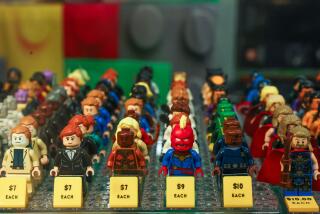Toy stores, under siege in the U.S., find new life in China
Toys R Us outlets are closed in the United States, but the brand’s stores are still a popular destination for Shanghai resident Pan Wei. A 35-year-old manager for an entertainment company, Pan does most of his shopping online but prefers physical shops when buying toys for his daughter.
“When it comes to products for kids, we want to make sure it’s safe, so we prefer going to toy stores,” he said.
More than a year after the New Jersey-based chain filed for bankruptcy, forcing the closure of hundreds of stores and layoffs of 33,000 workers in the United States, Toys R Us Asia is very much alive. Last month, a group of Toys R Us creditors reached a deal with the retailer’s Asian partner, Hong Kong-based Fung Retailing Ltd., to share control of the company’s stores in China, Japan and Southeast Asia.
Other international brands are also betting that Chinese consumers are willing to go to physical stores with their children or grandchildren. Favorites such as Lego Group and FAO Schwarz are among those targeting the Chinese toy-and-game market, which will be the world’s largest by 2022, according to Bloomberg Intelligence.
More children
The toy sellers are counting on changes in Chinese politics and society to help them gain a foothold in the world’s most populous country. President Xi Jinping’s government ended the one-child policy in 2016 and is taking steps to encourage women to have more children. Also, China’s product-safety scandals and notoriety for counterfeit goods have made parents more willing to spend on Western brands they perceive as safer.
Toys R Us Asia plans to add as many as 50 stores next year in China. It’s a big vote of confidence in bricks-and-mortar retail at a time when the growing popularity of e-commerce competitors contributed to Toys R Us’ failure in the United States.
“We are different than the rest of the Toys R Us world,” said Andre Javes, president and chief executive of the Asian business.
Net sales for China and Southeast Asia were $375 million for the year that ended Jan. 28, 2017, up about 3% from a year earlier, based on the company’s last available regulatory filing. Sales fell 3% in the United States over that period.
Many families in China’s big cities, who often live in relatively small apartments, still look forward to going on trips to shopping malls.
FAO Schwarz, the New York toy store where Tom Hanks danced on a floor piano keyboard in the 1988 Penny Marshall movie “Big,” plans its Chinese debut in the new year. After shutting its Fifth Avenue flagship in 2015, FAO Schwarz returned to New York in November with a shop in Rockefeller Center. Early next year, owner ThreeSixty Group Ltd. plans on opening a Beijing store near the Chinese capital’s 3rd Ring Road that will be larger than the Manhattan location.
ThreeSixty is partners with Hong Kong-listed Kidsland International Holdings Ltd. on the Beijing store, targeting China as part of a strategy to leverage FAO Schwarz’s reputation as an interactive destination for tourists and shoppers alike.
“Chinese consumers and especially millennials are looking for more than just buying an item off the shelf,” ThreeSixty Chief Operating Officer Jan-Eric Kloth said in a statement. “They want to be engaged and entertained.”
Plastic bricks
Danish toy maker Lego is taking a similar approach with outlets where Chinese children can play with the plastic bricks rather than just look at them in the box. The company has 55 stores in China, including a flagship that opened in September in central Shanghai. Lego plans to add 80 next year, according to spokesman George Yang.
Lego’s revenue fell in its established markets in North America and Europe in 2017 but saw growth in the high double digits in China.
Still, a famous Western name doesn’t guarantee fast growth in the Chinese toy market.
C.banner International Holdings Ltd., a shoe company based in the central Chinese city of Nanjing, agreed to pay about $125 million in 2015 for Hamleys, the British toy retailer. Three years later, the company operates more than 120 stores worldwide but only three stores in China.
Barbie flop
A high-profile flop for the industry came in 2011, when Mattel Inc. closed a six-story, 37,700-square-foot Barbie store in Shanghai, just two years after it opened. Mattel’s international net sales fell 18% in the third quarter, driven largely by weakness in China. Chief Financial Officer Joseph Euteneuer said in an October call with analysts that Mattel had a “self-inflicted” inventory surplus resulting from a misreading of Chinese demand.
“Mattel’s experience in China illustrates the difficulty Western-branded toy companies have still had in attempting to penetrate the world’s second-largest toy market,” BMO Capital Markets researchers led by analyst Gerrick Johnson wrote in an Oct. 29 report.
Toys R Us Asia is hopeful about the Chinese market, where its stores are typically smaller than the ones that were operated by its parent in the United States. Instead of big-box stores of about 45,000 square feet, the chain’s Chinese locations average 10,000 square feet and are in shopping malls, Javes said.
In China and other parts of Asia, “people go to malls for entertainment, food, socializing,” he said. “That makes us convenient for people because we are where they’re going.”
Einhorn and Wei write for Bloomberg.
More to Read
Inside the business of entertainment
The Wide Shot brings you news, analysis and insights on everything from streaming wars to production — and what it all means for the future.
You may occasionally receive promotional content from the Los Angeles Times.










